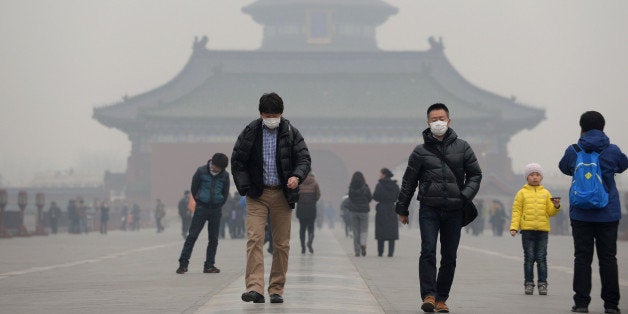
Last week, much of northern China was cloaked in a thick apocalyptic smog which many scientists likened to a nuclear winter.
Although pollution levels in Beijing have now subsided to "very unhealthy" from "hazardous," president Xi Jinping cited it as the biggest challenge facing the capital.
Last Tuesday, the concentration of the noxious PM 2.5 pollutant breached the 500 micrograms per cubic meter mark.
That's 20 times higher than the level recommended by the World Health Organization.
Two-and-a-half micrometers in diameter, the pollutant is especially toxic because once inhaled, it enters the bloodstream, causing asthma, cancer and heart disease.
Last week, the WHO urged all people to stay at home: "There's now clear evidence that, in the long term, high levels can actually cause lung cancer" warned Bernhard Schwartlander, the WHO's representative in China.
Citing several recent studies, the WHO said that lung cancer rates in Beijing have in fact doubled over the past decade.
The poisonous smog comes seven months after a groundbreaking report revealed that filthy air in northern China had shortened life expectancy by around 5.5 years.
Using pollution and health data from 1981 to 2000, the joint study by MIT in the U.S., Tsinghua and Peking University in Beijing, and the Hebrew University of Jerusalem, discovered that a rise of 100 micrograms of PM 2.5 per cubic meter shortened one's life by around three years.
Beijing's latest smog crisis comes two weeks after it was rated the second worst city in the world.
According to the Shanghai Academy of Social Sciences, "The pollution index nears extreme levels, and is near a level that is no longer livable for human beings."
That damning assessment came five months after China launched a $280 billion initiative to clean up its air, including plans to burn less coal and ban highly polluting vehicles.
But, in spite of the government's countless orders and decrees, Beijing's toxic air shows no real sign of abating.
Reining in China's air pollution is a complicated process: Coal fires much of the electricity and heavy industry in the north of the country.
Heavy industry is also the region's largest employer, and biggest taxpayer, so "it's a very sensitive issue because it's very much related to local GDP," said Ma Jun, one of the country's leading environmentalists.
Looking at Beijing specifically, two-thirds of its pollutants blow in from the nearby industrial province of Hebei. Hebei now produces less steel, and has shut down several smaller mills. The government has also scrapped new coal projects to the east of the country close to the capital.
But, by encouraging more projects in the west instead, it has simply shifted the problem from one side of the continent to the other. Moreover, by shutting down steel mills in Hebei, it has forced others to crop up in the south, subjecting Shanghai to record levels of smog this winter.
In the past, China pursued a "growth at any cost" model in order to become the world's second largest economy. But, now that the environment has become the leading source of social unrest, the government has to confront the crisis head on.
"[With the air], they feel the mass protest is just outside their door if they don't do anything. It's there, in everyone's eyes", said Li Bo from Friends of Nature, a Chinese environmental NGO.
Last month, President Xi Jinping made an unannounced visit to a neighborhood in Beijing in an act of solidarity with the people.
Walking around Nanluoguxiang without a facemask, Xi's brief visit prompted approving coverage in the Chinese state media. But, it also lead to some mockery: "Xi Jinping visits Beijing's Nanluoguxiang amid the smog: breathing together, sharing the fate."
The latest round of air pollution air comes two weeks after China joined forces with the U.S. to lead the charge against global warming:
In light of the overwhelming scientific consensus on climate change, and the related issue of air pollution from burning fossil fuels, the United States and China recognize the urgent need for action.
The move came five months after the United Nations warned that our planet is warming much faster than expected. Global temperatures may now near the four degrees Celsius mark by the end of this century.
Such a temperature rise will usher in changes not seen since the last Ice Age.
As the world's largest polluter, and next super power in the making, China certainly has a responsibility to act. It generates over 20 percent of all carbon emissions worldwide.
In order to stand by its recent pledge, China will have to take enormous strides to stamp out its use of coal. In the words of an old Chinese proverb: "It's not the cry, but the flight of a wild duck, that leads the flock to follow."
And, it already has the means: The world's most populous nation has overtaken the U.S. to become the leader in the clean energy race.
For decades, the Chinese leadership sacrificed the environment in order to achieve breakneck economic growth. Now, it will need to sacrifice its coal industry for the sake of both its people, and the very planet that we live on.
As the Chinese philosopher Lao Tzu once said: "All great acts are made up of small deeds. A journey of a thousand miles begins with a single step."
